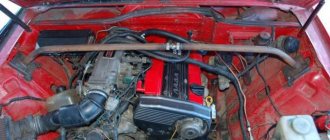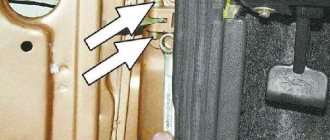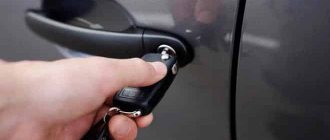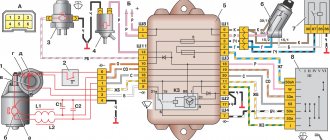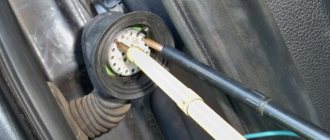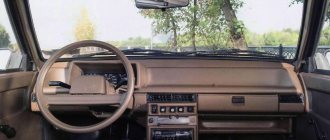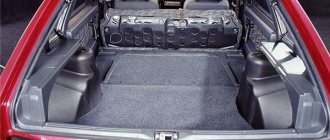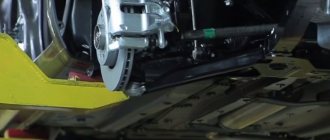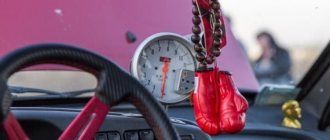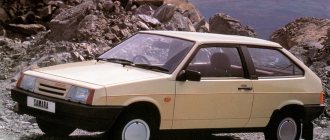In some cases, it becomes necessary to check the geometry of the car body. For example, when identifying hidden defects and distortions of the body after an accident or when checking the correctness of its repair. It should be noted that in addition to the established gaps, attention should be paid to the discrepancy between the stamping lines of the doors and wings on the same side. It is allowed within ±2 mm. The protrusion of hinged movable front panels should be within 3 mm.
Body clearances and dimensions of openings (doors, windows) VAZ 2108, 2109, 21099, side view
body clearances of VAZ 2108, 21081, 21083 cars (side view)
- The hood-fender-windshield frame gap is 7±2 mm.
- The door-wing gap is 7±2 mm.
- The gap between the door glass frame and the roof is 7±2 mm.
- The gap between the bottom of the door and the threshold is 7±2 mm.
- The gap between the rear part of the door and the rear wing is 7±2 mm.
- The rear door-roof gap is 9±2 mm.
- The gap between the rear door and the rear fender is 8±2 mm.
linear dimensions of openings (doors, windows) of VAZ 2108, 21081, 21083 cars
Linear dimensions of openings VAZ 2108, 2109, 21099, front view
dimensions of the hood and windshield of a VAZ 2108, 21081, 21083
Linear dimensions of openings VAZ 2108, 2109, 21099, rear view
dimensions of the rear door opening of VAZ 2108, 2109, 21099
Notes and additions
— Control of linear openings of bodies is carried out using a special measuring ruler. To roughly assess the condition of the car body, you can use a regular tape measure.
More articles on car bodies VAZ 2108, 2109, 21099
— Replacement of the windshield of VAZ 2108, 2109, 21099 cars
Comparative test repair
The VAZ 2109 was first produced back in 1988. The five-door design allowed this car to be used as a successful family commercial vehicle. At the same time, the car is often used for transporting small-sized cargo, as it is equipped with a fairly simple luggage compartment.
Dimensions Lada 2109 restyling 1991, hatchback 5 doors, 1st generation
| Options | Dimensions | Weight, kg |
| 1.1MT 21091 | 4006 x 1650 x 1402 | 915 |
| 1.3MT 21090 | 4006 x 1650 x 1402 | 915 |
| 1.5i MT 21093-20 Standard | 4006 x 1650 x 1402 | 920 |
| 1.5i MT 21093-21 Normal | 4006 x 1650 x 1402 | 920 |
| 1.5i MT 21093-22 Lux | 4006 x 1650 x 1402 | 920 |
| 1.5 MT 21093-00 Standard | 4006 x 1650 x 1402 | 945 |
| 1.5i MT 21093-20 Standard | 4006 x 1650 x 1402 | 945 |
| 1.5i MT 21093-21 Normal | 4006 x 1650 x 1402 | 945 |
| 1.5i MT 21093-22 Lux | 4006 x 1650 x 1402 | 945 |
| 1.5 MT 21093-01 Norm | 4006 x 1650 x 1402 | 945 |
| 1.5 MT 21093-02 Lux | 4006 x 1650 x 1402 | 945 |
| 1.5 MT 21093-20 Standard | 4006 x 1650 x 1402 | 945 |
| 1.5 MT 21093-21 Norm | 4006 x 1650 x 1402 | 945 |
| 1.5 MT 21093-22 Lux | 4006 x 1650 x 1402 | 945 |
From Moscow to Lisbon
Just a few minutes until the start at Manezhnaya. From right to left: Victor Panyarsky, Oleg Bogdanov, Vladimir Solovyov.
One of the most striking moments in the biography of the VAZ-2109 was the trans-European marathon Moscow-Lisbon, organized by the magazine “Behind the Wheel” in September 1988.
The history of this unusual motor rally began in July 1986, when journalists from Portugal K. Finu and N. Vashko arrived in Moscow in an Austin Montego. The travelers covered the route from Lisbon to Moscow in 51 hours and 30 minutes, an excellent result! The Austin crew returned to their homeland, and soon the Union of Journalists of the USSR received an invitation to pay a “return visit”. For the Portuguese, a motor rally “against the clock” was nothing more than an exciting sports competition. In the Soviet Union, such an event could only be considered as a “duel between two state systems”: socialism and capitalism.
Naturally, without the right to lose! The editors of Za Rulem, the country's main automobile magazine, were entrusted with defending the honor of the country in this non-standard marathon. The organization of the marathon immediately reached the state level: suffice it to say that the pilots’ diet was developed at the Research Institute of Medical and Biological Problems of the USSR Academy of Sciences. However, the success of the run depended primarily on technology. The main question had to be resolved: which Soviet car was capable of withstanding a high-speed rally from one end of Europe to the other. The answer suggested itself: of course, the newest model of the most modern VAZ-2109 plant.
By the summer of 1988, when preparations were underway for the marathon, the same 1.5-liter BA3-21083 engine was already tested at VAZ (but not yet mass-produced). It was decided that just such a car would be launched, powerful and at the same time economical (due to a five-speed gearbox). Especially for the record run, two identical “nines” were assembled at VAZ, which were then transferred to NAMI for testing. Only after both cars, driven by specialists, had covered 2,000 km at maximum speed, was the best car chosen. Despite the understandable desire to play it safe by replacing some of the parts in the car with imported analogues, this was not easy for component manufacturers to do
For obvious reasons, the West did not think about unifying any units with those used in Soviet cars. As a result, the “record” car was content with only a remote high-precision speedometer, a Bosch electronic ignition system, four additional Helta headlights and Michetin tires mounted on light alloy wheels. To be fair, it must be said that the success of the run largely depended on the tires: none of the serial tire models produced in the USSR at that time were designed for long-term driving at high speeds.
Early in the morning of September 14, 1988, a cherry “nine” with three “Behind the Wheel” journalists on board took off from the square
50th anniversary of the October Revolution in the center of Moscow. Forty-five hours later, the Soviet crew finished at the gates of the Portuguese capital, having covered a distance of 4811 km at an average speed of 107 km/h. It was a real triumph! To the credit of the “nine”, the car never caused any trouble to the pilots, although a good third of the journey was covered at a constant speed of 150-170 km/h (the autobahns of Germany and the expressways of France allowed driving in this mode without violating the rules). There were some force majeure situations, but they were caused not by technology, but by the human factor. Having made a mistake on the border of three countries, the crew of the “nine” ended up in the Netherlands instead of Belgium. The second curiosity happened at the entrance to Lisbon: at six o’clock in the morning the city gates were locked, and in order to get to the Belem Tower, the starting point of K. Fin and N. Vashko, the race participants needed the help of the press attache of the Soviet consulate in Portugal.
Initially, counting on the success of the event, the Ministry of Automotive Industry provided for the possibility of participation of the marathon “nine” at the Paris Motor Show. The “combat” car, already familiar to foreign car enthusiasts from television reports, took pride of place at the stand of the VAZ importer in France. Just before the opening of the exhibition, a funny incident occurred - noticing
There is a “1500” plate on the body of the car, the head of “Pok” ordered to replace it with a “1300” plate. Monsieur's logic So far was this: until the 1.5-liter modification goes on sale, potential buyers should not know about its existence. The expansive Frenchman’s request was granted, and the secret of replacing the nameplates was made public only twenty years later.
Control dimensions of the VAZ 2109 body
The body has a rather short length - 4006 mm, which is an obvious advantage of the car, since compactness is important in urban environments. If we compare the manufacturer’s previous models, the body length of the VAZ 21099 was reduced by 120 mm, while there was 60 mm more space inside thanks to rational and correct design solutions.
The first production VAZ 2109 cars had a body width of 1650 mm, however, after a few months, the developers managed to reduce it by 30 mm to 1620 mm, this further increased the compactness of the body.
The body height is approximately 1402, which is 30 mm comparatively less than the body of its predecessor models. But the designers were able to compensate for the free space by creating car windows in a convex shape. On the one hand, this made it possible to increase the amount of free space, on the other, it made the vehicle more presentable.
The luggage compartment of the VAZ 2109 deserves special attention, which at one time made a real splash on the passenger car market. Even today, this almost revolutionary design feature has not lost its practical relevance.
The standard trunk capacity of the Nine is 330 liters, but if necessary, it can be expanded to 640 liters by folding the rear seats. All this can be done in a couple of minutes and does not require much effort.
The front wheel track is 1400 mm, and the rear wheel track is 1370 mm. The compact dimensions of the VAZ 2109 body make it possible to efficiently transport small-sized cargo around the city, even during rush hour when there are a lot of traffic jams.
Note. The compact dimensions of the “nine” create opportunities for overtaking, since large passenger cars are practically unable to maneuver in traffic jams due to the lack of sufficient free space.
Description of design
The rear suspension is with 12 coil springs and 10 double-acting hydraulic telescopic shock absorbers.
The main load-bearing element of the suspension is a beam consisting of trailing arms 14 and a connector 13, welded together through reinforcements. At the rear, brackets 15 with eyes for attaching shock absorbers 10 and flanges for attaching the rear wheel axles and brake shields are welded to the suspension arms. At the front, the levers 14 are equipped with welded bushings with silent blocks 3 pressed into them. A bolt passes through the central bushing of the silent block, connecting the lever to the bracket 2. Three welded bolts are provided to secure the bracket to the body spar.
The suspension spring 12 rests with its lower end on a cup welded to the shock absorber reservoir, and with its upper end, through a rubber gasket 11, on a support welded from the inside to the body arch.
The lower eye of the shock absorber is bolted to bracket 15 of the suspension arm, and its rod is secured to the upper support of the suspension spring through two rubber pads 8 (one at the bottom of the support, the other at the top) and a support washer 7 (under the nut).
The rear suspension springs are divided into two stiffness classes according to their length in the free state and under load: A (more rigid, “high”) and B (less rigid, “low”). Springs of the same class must be installed on the front and rear suspensions. But in exceptional cases, if class A springs are installed in the front suspension, class B springs can be installed in the rear suspension (but not vice versa!). The quality of the springs can be fully assessed by the performance of the suspension on the car. If the suspension often “breaks through” to the bump stops on uneven roads or sags under load, stiffer springs should be installed. When replacing springs, do not forget to check the serviceability of the shock absorbers - after all, it is the shock absorber-spring pair that largely determines the characteristics of the suspension.
The hub has a double-row angular contact ball bearing, similar to the front wheel hub bearing, but smaller in size. The bearing fit on the axle is transitional (with slight interference or clearance). During operation, the bearing does not require adjustment or replenishment of lubricant. It is not allowed to eliminate the resulting play by tightening the nut; the bearing should be replaced. When dismantling the hub, the bearing is destroyed, so it is not recommended to disassemble the hub if the bearing is in good condition.
The VAZ 2109 was first produced back in 1988. The five-door design allowed this car to be used as a successful family commercial vehicle. At the same time, the car is often used for transporting small-sized cargo, as it is equipped with a fairly simple luggage compartment.
Place 21093 in the AvtoVAZ model line
The prototype for the VAZ 21093 was the front-wheel drive hatchback VAZ 2109 “Sputnik”, with a 1.3 liter carburetor engine, produced in Togliatti since 1987. Its engine power was 64 horsepower. Externally, the 21093 Samara, which appeared in 1990, was not much different from the 2109. Dimensions, design, design - everything was almost like the nine. The main differences were hidden under the hood.
Modification 21093 received a new engine. The designers of the Volzhsky Automobile Plant increased the cylinder diameter from 78 to 82 mm with the previous piston stroke of 71 mm. This resulted in an increase in the working volume from 1288 cubic cm to 1499. The car's power increased, its performance characteristics improved (speed and acceleration dynamics), and fuel consumption decreased slightly. In general, the VAZ 21093 car has acquired noticeable liveliness.
The VAZ 21093 Samara was produced in Tolyatti until 2004, giving way to the model 2114, a five-door front-wheel drive hatchback from the Samara-2 family.
Choice
Before you start replacing the silent blocks of the rear beam, you need to decide what exactly you will replace the old, worn bushings with.
We figured out the markings and realized that for the VAZ 2109 you need to take only those that are suitable in size and diameter for the rear beam of the nine.
Today, for the VAZ 2109 they offer two types of silents, differing in the material of manufacture.
The choice should be made based on the available budget. Rubber elements cost several hundred rubles less. As for manufacturers, we recommend paying attention to the companies SEVI, BelMag, Boge and SS20.
Size difference
Control dimensions for checking the geometry of the underbody of a VAZ 2108 (2109, 21099) car
Checking the control dimensions of the geometry of the underbody of VAZ 2108, 2109, 21099 cars is carried out by measuring the distance between certain points.
Control dimensions of the geometry of the underbody of VAZ 2108, 2109, 21099 cars
Control dimensions between points
- The centers of the front bolts for the front suspension braces (“crabs”).
- The centers of the front and left mounts (“mounts”) of the car engine.
- Front suspension arm hinge centers.
- Engine rear mount mounting points.
- Steering gear mounting bolts (“rack”).
- Steering rack mounting bolt - left engine mount.
- Rod of the right and left shock absorber of the front struts.
- Front strut shock absorber rod, rear strut shock absorber rod.
- Rear beam mounting bolts.
- Rods of the right and left shock absorbers of the rear struts.
Notes and additions
— A telescopic ruler for checking the geometry of the body can be purchased at the store, or you can make it yourself from scrap materials.
More articles on the body of VAZ 2108, 2109, 21099 cars
Rear suspension parts
1 – wheel hub; 2 – suspension arm mounting bracket; 3 – silent block; 4 – shock absorber casing; 5 – compression stroke buffer; 6 – casing cover; 7 – support washer; 8 – shock absorber cushions; 9 – spacer sleeve; 10 – shock absorber; 11 – rubber gasket; 12 – rear suspension spring; 13 – lever connector; 14 – lever of the rear suspension beam; 15 – shock absorber mounting bracket; 16 – lower spring support cup; 17 – rod; 18 – upper spring support cup.
Major body repair
Major body repairs involve complete disassembly of the car. It is necessary to remove everything from the car, from the power plant to the interior trim, and drill out the resistance welding areas. This will allow you to detect hidden defects and carry out repair work most efficiently and less expensively.
When disassembling, take the “VAZ 21099 Operating Manual” as a basis. Damage can be varied, but the most common complaints are:
- the bottom, especially the left side, the driver’s seat, is often subject to particularly intense corrosion in Togliatti-assembled cars;
- trunk niches;
- rear side members;
- thresholds and threshold amplifiers;
- wheel arches (due to the design features, pay close attention to the rear ones).
If the rust is deep, there are cracks in the structure, and parts are subject to corrosion, including through corrosion, and deep deformation, then a major body repair will not be possible without welding work. It is necessary to weld problem areas. In most cases, parts need to be replaced. To do this, you can use a grinder to cut off areas and structural elements that are susceptible to through corrosion. In some cases, you have to buy a new bottom or limit yourself to a trough without a tunnel, it’s cheaper.
It is advisable to restore the geometry of the body after complete disassembly of the VAZ 21099, but in the conditions of an ordinary garage, it is impossible to do this with your own hands without special equipment.
After completing the dismantling and welding work, critical areas must be thoroughly treated with an anti-corrosion compound and painting can begin.
How is recovery carried out?
As a rule, restoration of original forms is carried out these days in car repair shops. It uses special equipment, often electronic, a slipway and other useful tools to bring the car to its original condition.
Note. A special platform is called a slipway. This design implies a rigid machine with strong, perfectly geometric shapes. It is on the slipway that the vehicle is rigidly attached to the basic, fundamental points. The metal of spaced apart, deformed elements is also drawn out on the slipway to the required, original dimensions.
The operation of fine-tuning the original geometry of the body and its parts is considered very delicate. It definitely requires individual skill and increased accuracy. Without the necessary equipment, such as a slipway machine, it is almost impossible to complete it.
On the other hand, many craftsmen have adapted themselves in garage conditions to bring skewed body elements to the required dimensions. True, this is done with errors, but they imply a slight deviation from the original indicators.
Most often, in the current conditions, the car’s suspension has begun to fail. Such deformation occurs, clearly, due to bad roads. And its displacement is very difficult to determine. After the car falls into a hole or receives a strong impact, it is highly recommended to immediately check the condition of the car for wheel alignment.
You can learn more about the operation of the slipway from this video.
”
Device manufacturing process
Such an agricultural device as a walk-behind tractor has been used by summer residents as a working machine for many years. Thanks to him, a person’s labor in carrying out land work has become noticeably easier. When installed on an adapter with a seat, it will turn into a mini tractor. Picture 1.
With the help of a small tractor it is very convenient to cultivate the soil, mow the grass and prepare the ground for planting a new crop. In addition to working in the fields, a mini-tractor will be useful when transporting seedlings, fertilizers for plants or heavier objects.
Figure 1. Preparing the walk-behind tractor.
In this matter, an important role is played by the trailer (trolley), which is connected to the walk-behind tractor. Its main function is to transport heavy loads, construction materials and other agricultural items.
In winter, a walk-behind tractor is simply an indispensable device for cleaning roads. To get rid of excess snow, you can load it into a homemade trailer for a walk-behind tractor with your own hands from a VAZ 2108 beam. Figure 2.
Unlike factory models, you can make a device of the desired size, you just need to correctly draw up a drawing. And the whole design does not require any special costs compared to store-bought counterparts.
Features of elements
The main function of silents is to eliminate vibrations and deformations that occur during vehicle operation.
When choosing new silent blocks for the rear beam of a VAZ 2109, pay attention to the markings. It should be 2109-2914054. For VAZ 2114-15 models, the markings are different, but the elements themselves are very similar.
In principle, it is possible to install a silent block from a dozen on a VAZ 2109, but you will have to work hard with pressing in the rubber bushing due to the difference in size. The reverse procedure is not possible.
Rear beam
Preparatory work and elimination of minor damage
Where to start repairing the VAZ 21099 body? In any case, it must begin with an assessment of the technical condition of the car and determining the scope of body work, its feasibility and cost. To do this, you need to inspect the car and identify:
- dents and other deep damage;
- possible chips;
- scratches;
- peeling of paintwork;
- presence of rust.
It is possible to eliminate minor damage yourself if you have special tools and devices that every car owner has. The car's structure allows you to perform simple manipulations after dismantling some body elements. First of all, you need to remove the following parts:
- doors;
- trunk top;
- hood;
- radiator grille;
- bumpers.
Next, these parts should be treated with a special anti-corrosion agent. It is necessary to take into account that each part weighs a lot, so for such work, as a rule, you will need an assistant.
Before painting is carried out, damage with rusted edges requires immediate elimination, since corrosion is an irreversible process and the area of damage can quickly grow. The procedure for doing body work with your own hands involves performing a number of actions.
- Removing the old layer of paint from the entire surface area of the part using an electric drill with an attachment.
- After cleaning the part from the paint, you can understand how much space the rust occupies.
- Damaged areas of the part are removed with special scissors.
- Use a hammer to bend the edges inwards for ease of applying putty.
- To remove rust from a VAZ 21099 part, use a metal brush.
Their efficiency and quality depend on how well the sequence of work is followed.
Linear dimensions of the car body
If your car is accidentally hitched in a parking lot and small dents appear, there is no reason to panic. How much will such a repair cost? How long will it take? There is only one answer to these questions - not much, if you repair the device yourself. To do this, you will need to remove the damaged part and install a new one. If she doesn't weigh too much, she won't need a partner.
Structural diagram
As already mentioned, the layout is simpler at the back than at the front. Nevertheless, this cannot be said that it is not worth paying attention to its functioning. We will provide a design diagram of the device.
Knowledge about all the features and nuances of the structure of this important unit will simplify its care. At any time, minor breakdowns can be repaired independently, without involving specialists. There is also no need for special consultations on the selection of components. So, the main components of the suspension:
- central curved beam;
- longitudinal lever mechanisms;
- brackets for fastening;
- spring mechanisms;
- hydraulic shock absorbers.
Control points of the body geometry of the VAZ 2109
MegaDED 07 Oct 2009, 16:59
Help me find Body Floor Control Points 21099
Re: body geometry, 21099
8ter 07 Oct 2009, 22:36
if anyone needs 08-09:
Re: body geometry, 21099
Fray 07 Oct 2009, 22:55
Re: Check points for VAZ 2108-099 bodies
Monaxms 06 Nov 2009, 05:00
Everything in life is relative BUT for some reason they always hit you from behind (((
Re: Check points for VAZ 2108-099 bodies
Fray 06 Nov 2009, 12:12
Front strut
The most popular element, widely used by many owners of Russian cars, is the front cross brace.
Its installation is carried out in the area of the upper shock absorber supports, by securing it between the strut cups.
The main purpose of this part is to increase the angular rigidity of the body and improve the handling quality of the vehicle.
In addition, the presence of a spacer helps eliminate the “floating” geometry of the suspension arms, which occurs as a result of strong impacts on road potholes or uneven surfaces.
The main reason why many car enthusiasts, in particular owners of VAZ cars, make such modifications is due to insufficient body rigidity, which contributes to deterioration of handling, a feeling of “sluggish” steering and excessive roll that occurs when performing maneuvers.
This is detected only when driving at high speeds, mainly associated with trips on country roads.
Those drivers who spend most of their time within the city and are accustomed to a calm, leisurely drive may not notice these shortcomings.
The spacer is a fairly thick metal rod, either of a fixed length, intended for specific car models, or endowed with the possibility of spatial adjustment, facilitating the installation of the element on different cars.
Its installation is carried out when the machine is placed on a flat surface by screwing several nuts onto the upper studs of the shock absorber mounts.
If for some reason there is a mismatch between the mounting holes, the car body must be slightly “pulled” in the desired direction.
Installing a crossbar makes a certain amount of sense. You will not only significantly improve the car’s handling, but also extend the “life” of its body, thanks to improved torsional resistance.
Possible consequences
The correct geometric parameters of the car are the safety of the driver and passengers. Relative to the position of the power elements of the body, the angle of each of the wheels of the car is set. If the geometry is violated, the wheel alignment measuring system will never meet the standard. If the body moves relatively little, the technician will adjust the position of the wheels, but not for long.
Changes in geometry lead to the fact that the bottom is gradually deformed, folds appear in long body elements in the intervals between welding points, and the safety characteristics of the structure are noticeably reduced.
In a head-on collision, the engine should collapse underneath. If the dimensions of the body are violated, the engine will fly into the cabin, the risk of death for the driver and passenger increases by 50%.

